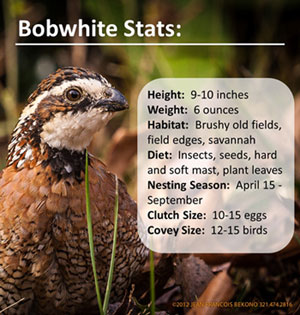 Whether it’s the pleasure of their company-watching them scurry across the lawn, listening to the male’s distinctive call-or their unsurpassed qualities as a game bird, quail have long been treasured by landowners, “bird” hunters and those who simply enjoy the sound of “bob-white”.
Whether it’s the pleasure of their company-watching them scurry across the lawn, listening to the male’s distinctive call-or their unsurpassed qualities as a game bird, quail have long been treasured by landowners, “bird” hunters and those who simply enjoy the sound of “bob-white”.
To anyone who’s ever been charmed by their presence or challenged by their flight, the appeal of bobwhite quail does not diminish. Unfortunately, their numbers have. In Virginia, an estimated 70 percent decline in bobwhite population since the mid-1960s may seem conservative to some, as quail are now gone from many of their former locations. Most responsible has been the decades-long era of modern land-use that has severely reduced the availability of suitable habitat.
Throughout their history, the fortunes of bobwhites have been determined far more by chance than design. With few exceptions, the applied management of quail habitat has been overlooked or disregarded. As current land practices continue to work against the bobwhite, landowners wishing to have quail on their property must now consciously apply the practices necessary to meet the bobwhite’s needs.
By the wealth of knowledge compiled over the past 70 years, the bobwhite’s requirements have been well defined and the means that will provide suitable habitat successfully demonstrated. More art than science, providing quail habitat in this hi-tech world is “down to earth”-disturbing the soil, modifying vegetation. Most of the techniques and tools employed are as old as those used in nineteenth century agriculture. To be successful, one also must understand the quail’s unique behavior and be able to recognize and implement the subtle characteristics of habitat that quail demand.
Click on a link below to begin learning about bobwhite behavior!

